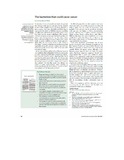| dc.description.abstract | Biopsy specimens were taken from intact areas of
antral mucosa in 100 consenting consecutive patients
presenting for gastroscopy at the Royal Perth Hospital, Perth, Australia. Spiral or curved bacilli were found in biopsy specimens
from 58 patients. The bacteria were usually found in close contact with
the mucosa, often in grooves between cells, within
acinus-like infoldings of the epithelium, or within the mucosal pits. Gram-negative, flagellate, microaerophilic bacilli cultured from 11 biopsy specimens seemed to be a new species related to the genus campylobacter. The bacteria were sensitive to tetracycline,
erythromycin, kanamycin, gentamicin, and penicillin,and were resistant to nalidixic acid. The bacteria were present in almost all patients with
active chronic gastritis, duodenal ulcer, or gastric ulcer. Therefore, they might be an important causal factor in
these diseases | en_US |

